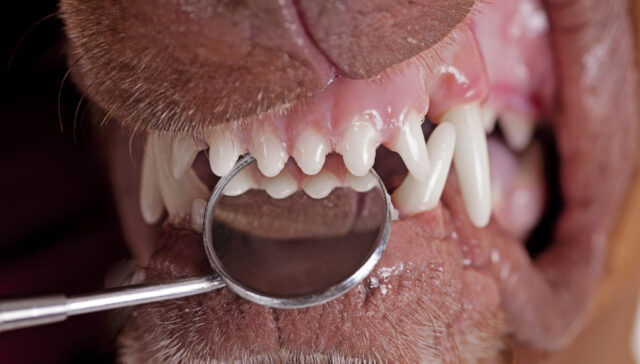
Table of Contents
The truth is, it’s difficult to tell whether your dogs are hurting or not.
Even the most meticulous owner may find it hard to translate the weird behavior their pups are showing.
That’s why Dr. Tony M. Woodward, owner of Montana Pet Dentistry and Oral Surgery, strongly reminds dog owners to religiously take their furry ones to the vet for annual check-ups.
Pain from dental disease comes on slowly and the pets just learn to deal with it.
If left untreated, dental diseases will take their toll on your pup’s health, especially since eating can be compromised.
So, if you need to have your pup’s tooth removed, you’ve come to the right place.
In this blog, I’ll share with you simple tips to aid your dog’s recovery phase.
Refer to this guide to conveniently navigate the page:
Let’s dive in!
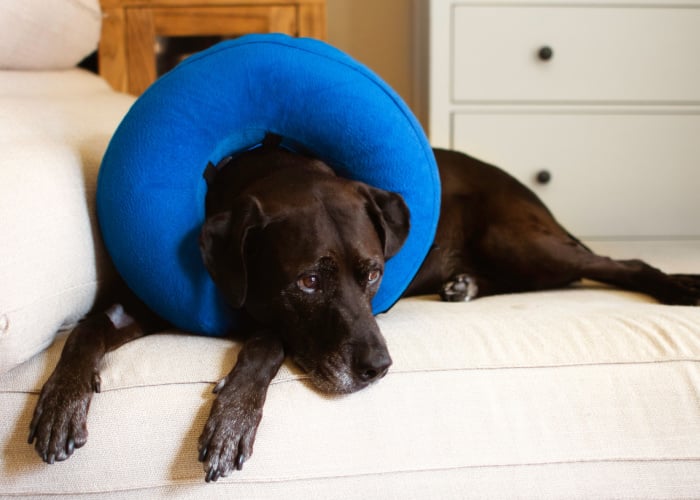
9 Tooth Extraction in Dogs Aftercare Tips
Tooth extraction in dogs is not a rare occurrence.
So, if this is your first time dealing with it, here’s a list of tooth extraction in dogs aftercare tips to help you get started:
1. Monitor your dog’s recovery
After tooth extraction, you’ll notice your dog getting weak or sleepy all the time due to surgery.
There’s nothing to worry about here since this condition is caused by the anesthesia or other painkillers administered to your dog during the procedure.
Important: Your dogs should regain their energy levels after a couple of days after tooth extraction.
Besides weakness, your dogs can also normally experience the following in the extracted area:
- Pain
- Swelling
- Minor bleeding
Note: Your dog will normally experience pain after tooth extraction for about 4 to 5 days.
However, watch out for the following warning signs of complications in your dogs after tooth extraction:
- Vomiting
- Diarrhea
- Depression
- Severe pain
- Heavy bleeding
- Increased drooling
- Changes in behavior
- Excessive or prolonged swelling
- Loss of appetite for more than 2 days
- Extreme weakness for more than 2 days
If any of these cases arise, seek veterinary help immediately.
2. Give their meds on time
A vital part of your dog’s recovery is your commitment and time.
So, monitor your pup’s medications religiously.
After tooth extraction, your vet may prescribe topical or oral pain relievers for your dog.
These medications don’t just lessen the pain your dog is feeling. It also quickens the healing process.
3. Keep your dog’s stitches intact
After tooth extraction, your dog will have stitches on the affected area, which usually dissolve within 2-4 weeks, depending on the material used.
These stitches are used to close the gums to prevent further infections.
Depending on the case, your vet will recommend replacing it.
But pay close attention; your dog might accidentally rip these stitches.
So, use an Elizabethan collar or cone to prevent your pups from pawing their mouth excessively.
Tip: You can choose a pillow-like e-collar or cone that’s comfortable for your pup, like the ones from KONG.
4. Restrict playtime and other activities
After your dog undergoes tooth extraction, it’s important to confine them for optimal recovery.
And in the next 7-14 days, restrict activities not limited to the following:
- Running
- Jumping
- Visiting dog parks
- Rough playing with other pets or children
Be sure to also put your dogs on a leash for a few days to limit their movements and monitor how often they use their litter bin.
This ensures other health issues are properly documented or addressed when visiting your vet for a follow-up.
Note: Some dogs may not have a bowel movement for 1-3 days after tooth extraction.
This delay typically results from various factors, such as the following:
- Anesthesia
- Decreased food intake pre-surgery
- Pain medications that can slow down the GI tract
Your pup may also have a mild cough for a few days due to a breathing tube placed in the trachea during the surgery.
5. Refrain from brushing your dog’s teeth
It might sound unsanitary, but brushing your dog’s teeth post-surgery can only cause further discomfort and infection.
Your vet will advise you for a follow-up, so just wait until they give you the go signal.
6. Don’t give chew toys
Apart from brushing your dog’s teeth, you should also avoid giving it chew toys, bones, or anything hard that they’ll likely munch on.
That’s because your dog’s stitches can rip out and cause bleeding and discomfort.
And in severe cases, further infections.
7. Feed your dogs soft food
After tooth extraction, offer your dogs some water and a small amount of their normal food to prevent them from vomiting.
If you feel like your pups are still hungry, don’t worry; you can feed them more food gradually at nighttime.
You can then feed your dogs on their regular schedule the next day.
But remember, only feed your pups a soft diet (canned or not) for at least 7-14 days.
Note: If your dog normally eats hard food, soak it in water for 15 minutes or until soft before feeding.
Related: Semi-Moist Dog Food: Pros, Cons, and Best Brands
8. Apply an ointment to your dog’s shaved leg
You might wonder why a spot in your dog’s leg is shaved.
That’s because an IV catheter was inserted into one or more areas of your pup’s leg.
To decrease itching and redness, apply 1% hydrocortisone ointment to this shaved area several times daily.
9. Clean your pup’s eyes
After tooth extraction, you can notice your dog’s eyes to be slightly greasy.
This is due to the lubricant that was applied to their eyes since dogs don’t normally close their eyes while under anesthesia.
Nothing to worry about; just gently clean your dog’s eyes with a warm washcloth.
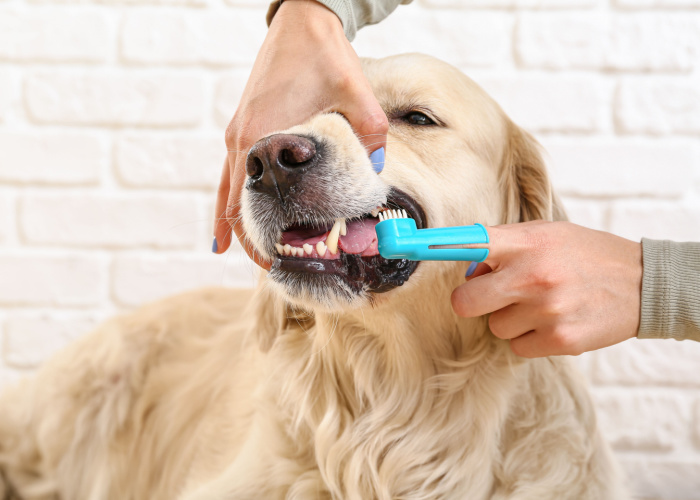
How to Keep Your Dog’s Teeth Healthy
They say, “Prevention is better than cure.”
And rightfully so, preventive care is the best form of treatment you can encourage your doggos to live by at home.
So, taking your pups to your vet for dental check-ups is a must.
But for your reference, here are some important ones to take note of:
1. Brush your dog’s teeth regularly
When done on a daily basis, you can help reduce plaque and tartar buildup in your dog’s teeth.
Thus, reducing the risks of the following:
- Tissue infections
- Periodontal disease
- Gingivitis or inflammation of the gums
Brush your dog’s teeth at least 2x a day is ideal according to experts of the VCA Animal Hospitals.
Types of toothbrushes your dog can use
There are specific types of toothbrushes that have various uses, such as the following:
| Type of Toothbrush | Purpose |
| With angled handles | More controlled grip |
| With multiple heads | Simultaneously brush the inside, outside, and top surfaces of the tooth |
| Small brushes | Comfortably fits in your hand; more controlled grip |
| Finger toothbrushes | Fits over the tip of your finger |
If you are uncertain about which type of toothbrush to use for your dogs, consult your vet.
Is it OK to use human toothpaste for my dogs?
Don’t use human toothpaste for your dogs when brushing their teeth.
That’s because toothpaste made for humans contains ingredients that are not suitable for pets when swallowed.
“Some human toothpastes contain high levels of sodium which may even make your pet ill, while others may contain xylitol (artificial sweetener), which is toxic for dogs.”
This is a reminder from experts of the VCA Animal Hospitals. Use pet toothpaste at all times.
Related: How to Pick the Right Toothbrush for Your Dog
2. Water additives
As Dr. Bert Gaddis, DVM, DAVDC suggests:
Dental rinses and water additives are designed to complement traditional toothbrushing.
Water additives are oral hygiene products that you can use for your dogs.
To fight plaque and tartar build-up that results in cleaner teeth and gums for your dog, add the prescribed amount to its drinking bowl.
Yup, it’s completely safe for your pups to drink it.
Not only does this product break down your dog’s plaque, but it also acts as a disinfectant.
That’s because this product prevents bacteria from lingering in your pet’s food bowl.
Reminder: These products should not replace your dog’s daily brushing.
3. Dental food
Besides daily brushing, you can also encourage another healthy approach to optimal oral health for your dogs which includes the following:
Raw meaty bones
Not just a yummy treat but a great way to break down plaques in your dog’s teeth, too!
Important: Give a suitable bone size to your dogs to prevent choking.
It’s also important not to cook the bone before giving it to your pup.
Cooking breaks down the bone’s density and structure, easily breaking it into small sharp pieces.
Related: The Best Bones for Dogs to Chew
Vegetables and fruits
Another great way to scrape food off your dog’s teeth is by feeding them vegetables and fruits.
These goodies contain antioxidants to help your dog deal with chronic oxidative stress causing periodontitis.
To help you get started, go for carrots, apples, and pumpkins since most dogs enjoy them.
Plus, they won’t annoyingly stick to your dog’s teeth.
Remember: Give vegetables and fruits only sparingly and keep your dog’s vet-recommended diet at all times.
Dental chews
Dog treats and oral hygiene wrapped into one?
Yup, dental chews work best in cleaning your dog’s teeth by, well, joyfully chewing and enjoying the product’s savory taste.
What’s good is that dental chews are designed for your pup’s oral health.
Not to mention jaw muscle development, stronger teeth, and fresher breath.
Note: Consult your vet for the best flavor to give your pups to prevent upset stomachs.
4. Dental wipes
Another way that complements teeth brushing in your dogs is the use of dental wipes.
Especially when you’re outdoors, using this oral product comes in handy in cleaning your pup’s mouth or teeth.
Also, if your pooch hates you brushing their teeth the second time (recommended), you can alternatively opt to wipe them instead.
Relate: The Ultimate Guide to Dog Dental Care
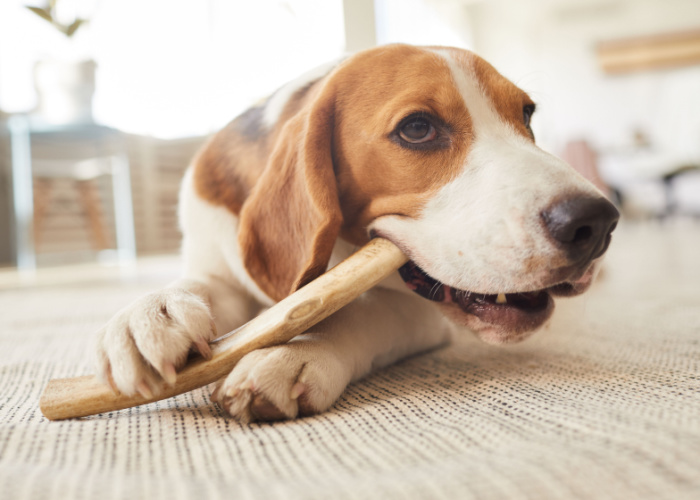
Tooth Extraction in Dogs Aftercare: FAQs
How long will my dog be in pain after tooth extraction?
Your dog will normally experience pain after tooth extraction for about 4 to 5 days.
Vets typically prescribe a topical or oral pain reliever medication to help aid your dog’s discomfort.
However, contact your vet immediately when you notice your dog is in severe pain or starts acting abnormally, like refusing to eat or drink.
What are the warning signs that my dog is experiencing complications after tooth extraction?
Your dog can normally experience pain, swelling, weakness, and the presence of blood in the affected area after tooth extraction.
However, take note of the signs of complications, such as severe pain, excessive swelling, increased drooling, heavy bleeding, extreme weakness, loss of appetite, and changes in behavior.
Take your dog to the vet immediately.
Will my dog have stitches after a tooth extraction?
Your dog will have stitches on the affected area after tooth extraction, which will usually dissolve within 2-4 weeks.
To aid in the healing process, stitches should not be removed.
Sometimes, your vet will recommend replacing it, depending on the case.
But if your dog accidentally rips the stitches, call your vet immediately, as this can lead to infection.
How active will my dog be after tooth extraction?
Your dog will feel unsteady or weak from the anesthesia and the entire procedure.
But after a few days, your dog should regain its normal energy levels.
So, be sure to give them a comfortable rest as much as possible and be sure to avoid strenuous activities or going to the dog park in the meantime.
Can I bathe my dog after a tooth extraction?
It’s impractical to take your dog to a bath after tooth extraction because its body is still coping with the aftereffects of the procedure.
It’s important to monitor your pup’s condition in the first few days following the surgery.
To be sure, wait for at least a week or 2 before bathing your dog.
Best to also consult your vet about this matter.
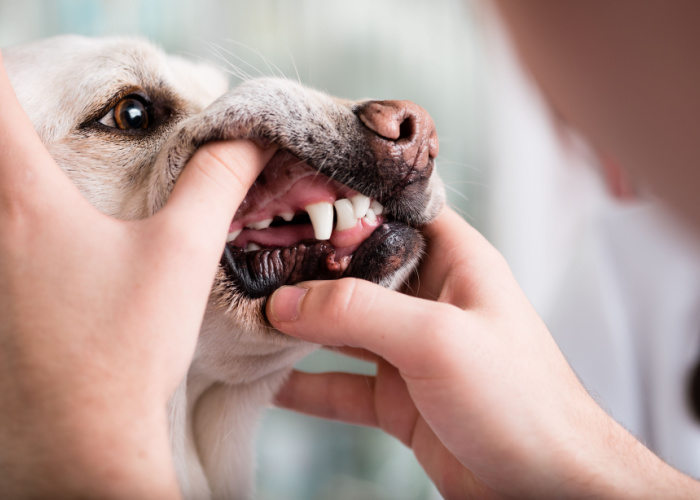
Tooth Extraction in Dogs Aftercare: Before You Go…
When your dog needs to have its tooth removed, you must consider both pre-surgery and recovery care.
It’s important to keep your dog’s body conditioned before and after the procedure.
So, I hope this tooth extraction in dogs aftercare tips I compiled today have helped you in any way.
Up for more of this topic? Check our recommendations below.












